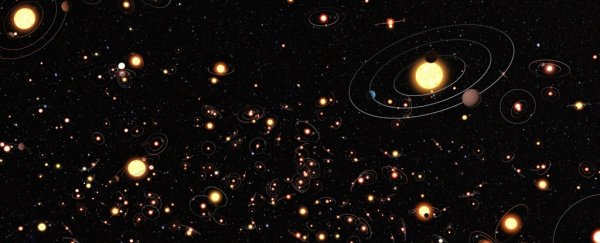We tend to think of planets neatly ordered in systems, like our own Solar System. But every now and then, astronomers get hints of something else - rogue planets, not attached to any star or system, drifting lonely through the galaxy.
Now it turns out there could be many more of them than anyone ever suspected. A new simulation has revealed that there could be billions of rogue planets in the Milky Way.
Taking a census of exoplanets is an extraordinarily tricky business at the best of times, when they're in a planetary system. Planets don't give off any light of their own (unless we're faced with a brown dwarf, but their planet status is debatable), so we have to use other means of detecting them.
When a planet is orbiting a star, there are two main detection methods. These are the radial velocity method, whereby the planet's gravitational effect on the star can be detected, and the transit method, when the planet orbits in front of the star and slightly dims its light.
As you can see, both of these methods rely on the presence of a star - so they're pretty useless when it comes to rogue planets. Nevertheless, there are still some ways we can detect these wanderers. Two rogue planets were spotted last year because of the way their gravity bends light coming from behind them; infrared imaging has revealed others.
In all, around 20 rogue planets or candidate rogue planets have been identified, compared to 3,917 exoplanets in planetary systems. That's a pretty huge gap.
So, to find out how many rogue planets might be out there, drifting darkly through the galaxy, astronomers at the University of Leiden in The Netherlands ran sophisticated mathematical simulations of the Orion Trapezium, a cluster of young stars in the heart of the Orion Nebula.
Five hundred Sun-like stars were modelled with four, five, or six planets each, for a total of 2,522 planets in all, with masses ranging from around three times that of Earth to around 130 times the mass of Jupiter (that's brown dwarf-sized).
Of these planets, 357 (16.5 percent) became unbound from their systems within 11 million years of forming, and drifted free. A few stayed within the cluster, and five were captured by other planetary systems, but 282 - the majority of the planets - escaped the cluster completely.
Interestingly, 75 of the 2,522 collided with their host star, and 34 planets collided with another planet.
Most of the rogue planets we've actually observed (which is a very small number) have been on the larger side. But the researchers found that a planet's mass was unlikely to have an effect on the likelihood it would be ejected from a system.
So rogue planets probably run the same gamut of sizes as planets bound by a system. There are probably smaller rogue planets out there - they're just that much harder to detect, among an already hard-to-detect class of objects.
If the 16.5 percent figure can be broadly extrapolated across the Milky Way (which is possible, given the Trapezium Cluster is pretty typical of a stellar nursery), then there are at least 16.5 billion rogue planets wandering around, of the estimated total of at least 100 billion planets.
It's even possible that our own system had an extra planet once upon a time that got booted out. It's thought that Uranus' weird axial tilt could have been caused by a collision with a rogue planet, and it's even possible that the mysterious and hypothetical Planet Nine was a rogue that got captured as it passed by.
As the researchers note, the study is based on only two simulations, so it's certainly not definitive - but the simulation evidence does indicate rogue planets are much more common than what our observational evidence suggests.
And it certainly sparks the imagination - these cold, lonely planets, traversing space far from the warmth of a star. Someone should definitely write a science fiction movie about that.
The research has been accepted into Astronomy & Astrophysics, and can be read on arXiv.
